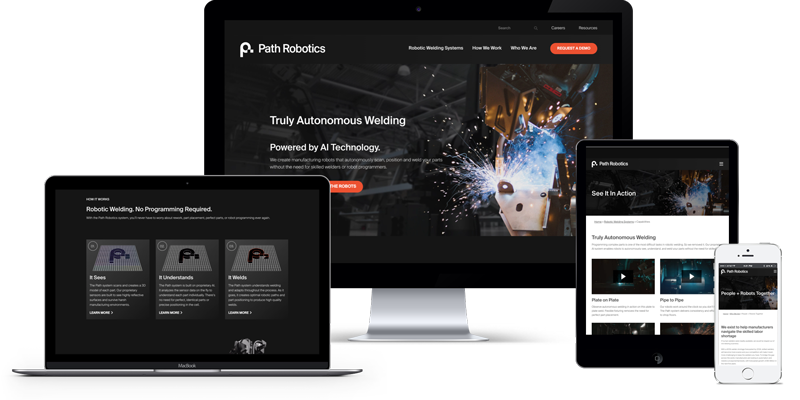Understanding the Duty of Responsive Layout in Modern Web Site Advancement
In today's digital landscape, responsive style is no much longer a deluxe however a need in website advancement. The relevance of receptive layout expands past user experience-- it is also a vital aspect in search engine optimization and access.
Importance of Responsive Design
In today's digital landscape, the significance of responsive style in site advancement can not be overemphasized. As customers progressively rely upon a selection of tools-- ranging from desktop to tablets and mobile phones-- making sure a smooth individual experience across all platforms has ended up being necessary. Responsive design allows sites to immediately change their design and performance based upon the display size and orientation of the tool being used. This versatility enhances customer interaction and satisfaction by giving constant access to content without calling for hands-on modifications such as zooming or scrolling.
Furthermore, receptive style is important for search engine optimization (SEARCH ENGINE OPTIMIZATION) Search engines like Google focus on mobile-friendly web sites in their search results page, meaning that a receptive design can considerably affect a site's exposure and position. This optimization not only boosts the individual experience yet likewise drives natural traffic and raises the potential for conversion and profits generation.
Furthermore, receptive design uses companies a cost-effective remedy by getting rid of the need for numerous versions of a web site. By streamlining web growth processes and minimizing maintenance initiatives, companies can designate resources extra efficiently, inevitably leading to enhanced return on financial investment. Thus, responsive layout is indispensable in today's affordable electronic atmosphere.
Key Components of Responsive Style
To effectively apply responsive style, it is important to concentrate on numerous crucial elements that make sure optimum capability and user experience across diverse devices. One of the fundamental components is the flexible grid design, which enables designers to produce liquid grids that immediately change to various display sizes. This makes sure that material preserves symmetry and readability, despite the gadget being utilized.

Furthermore, touch-friendly navigating is indispensable for responsive design. Implementing easily tappable buttons and intuitive gesture controls enhances use on touchscreen tools. Focusing on efficiency optimization is additionally critical, as it boosts filling times and minimizes bounce prices, especially on mobile networks with variable speed.
Last but not least, utilizing a mobile-first method ensures that the style is at first maximized for smaller displays before broadening to accommodate desktops. This approach assures that important performance and looks are protected throughout all systems, inevitably boosting the general customer experience.
Influence On User Engagement
Responsive style dramatically influences user engagement by enhancing availability and contentment throughout different tools. By guaranteeing that a website's design adapts flawlessly to different screen sizes, receptive style enables users to accessibility material effortlessly, whether they are utilizing a desktop computer, tablet, or smart device. This versatility reduces the need for unnecessary zooming or scrolling, providing a more her response pleasurable and intuitive browsing experience. Therefore, users are more probable to remain on the website longer, discover added web pages, and engage with the material, all of which are vital signs of raised involvement.
In addition, responsive design adds to quicker web page filling times, which is critical for maintaining individual rate of interest. Customers are extra likely to abandon a website if it takes also long to lots, especially on mobile phones. By maximizing performance for varied platforms, receptive layout lessens filling hold-ups, maintaining individuals involved and reducing bounce rates.
SEO Advantages of Responsive Layout
While enhancing user experience is a key objective, responsive design likewise plays an essential function in improving an internet site's search engine optimization (SEO) Responsive design makes certain that a redirected here website adapts to numerous display dimensions, getting rid of the requirement for separate mobile and desktop variations.
Additionally, receptive design aids in faster web page filling times, a crucial variable in search engine optimization. Internet search engine prefer web sites that fill promptly, acknowledging that users are most likely to desert sites that take as well lengthy to display. By using receptive design, designers can maximize photos and enhance content, making certain reliable loading and enhanced internet search engine rankings.
Furthermore, a natural link structure across gadgets simplifies the indexing procedure for search engines, improving crawl effectiveness. This uniformity in Links reinforces a web site's authority and reliability, causing improved presence in search results. In recap, receptive layout is not simply a fad however an essential part of search engine optimization approach, ensuring websites are both user-friendly and search engine compatible.
Applying Responsive Design Strategies
In the world of modern internet advancement, carrying out responsive layout approaches is similar to crafting a flexible canvas that changes seamlessly to various display dimensions. Central to this strategy is making use of adaptable grid-based designs, which utilize loved one systems like percents rather than dealt with systems such as pixels. This ensures that material ranges properly throughout devices. An additional vital tactic includes using media queries, which make it possible for developers to apply various styles based on the features of the device, such as width, resolution, and elevation.
Responsive pictures and media are additionally essential components. By utilizing methods like CSS media questions and the HTML 'image' element, developers can serve properly sized photos based on the individual's tool, optimizing lots times and enhancing user experience. Furthermore, the consolidation of liquid typography guarantees that text is clear and aesthetically pleasing on any display, achieved via scalable units like 'rem' and 'em'.

Final Thought
Responsive design comprises a vital element of contemporary web site development, dramatically improving customer experience across an array of gadgets. Inevitably, carrying out receptive style strategies makes sure improved availability and usability, making websites a lot more user-centric and efficient.
To properly execute receptive design, it is necessary to focus on several key components that guarantee optimal functionality and user experience throughout diverse devices.Receptive style substantially affects customer engagement by improving accessibility and satisfaction across different tools. By ensuring that a site's design adapts flawlessly to various screen sizes, responsive style permits customers to accessibility content effortlessly, whether they are utilizing a desktop, mobile phone, or tablet computer .While improving customer experience is a key objective, receptive design also plays a critical role in improving a site's search engine optimization (SEARCH ENGINE OPTIMIZATION)Receptive layout comprises an important element of contemporary internet site advancement, substantially improving individual experience across a range of tools.